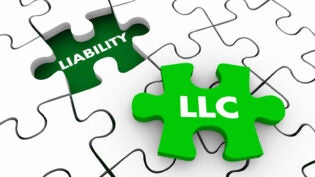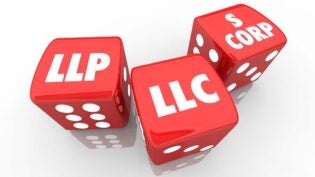
A Limited Liability Company (“LLC”) is a hybrid business entity which contains elements of a partnership and a corporation. LLCs consist of members and managers. An LLC may provide tremendous benefits for its members, which include asset protection, intergenerational transfers, tax saving strategies, wealth preservation, flexible management structures, and clarity on the roles of all essential parties involved in the company as set out in the Operating Agreement.
The following five concepts are fundamental for establishing an LLC: Asset Protection, Intergenerational Transfers, Tax Saving Strategies, Management, and Funding.
Asset Protection
Generally, the more assets a person owns in one’s name, the more likely it is that he or she will be a target mark for creditors. This is why it’s good practice to own as little as possible in your own name. In order to accomplish this goal, it’s important to evaluate the types of asset protections tools that are available to you. An LLC is one such tool that is effective for asset protection purposes.
For creditors of the LLC itself, a member’s personal liability will generally be limited to the amount of the member’s investment in the LLC unless the member personally guarantees the transaction in question.
For creditors of the member of the LLC, a creditor is generally precluded from acquiring an interest in the debtor-member’s interest in the LLC if the judgment was entered after the LLC was formed. However, most states allow for a judgment creditor to levy on assets after distributions have been made to the debtor-member by the LLC.
As a general rule, a creditor has no right to become a member, compel a distribution, or demand company assets. If such rights were given to a creditor, then the other members of the company would suffer from an action or inaction of a particular member. This would inevitably lead to an unjust result for the remainder of the group. Therefore, the creditor must wait until distributions are made to the member before any potential recovery can be pursued.
Another limitation on a creditor’s pursuit on a claim against the debtor-member is that an Operating Agreement has the power to prevent non-members from acquiring an interest in the company. This is especially important in the case of failed marriages and judgment creditors because courts may at times issue overreaching rulings in order to accomplish an equitable outcome in the event of divorces or other circumstances. An LLC can also provide the means for family members or ex-family members who are in dispute to not be compelled to communicate at the time their interest is being transferred from their donors to them.
There is another layer of asset protection that deals particularly with the recipients of the LLC interest. It’s standard practice for owner-members to make gifts to their heirs throughout their lives. Several problems are immediately surfaced when gifts of substantial value such as property or a significant amount of cash are transferred to their heirs. Without a proper plan in place, the recipients are likely to subject these assets to waste or relinquish them to creditors or former spouses. However, the transfer of an interest in the LLC can protect these assets from loss or waste by the recipient-members.
Keep in mind that the asset protection planning must be done well in advance of any anticipation to a claim. That’s because fraudulent transfers are broadly construed. Intent is generally presumed if a transfer is found to have been made before or after the claim arose with the intent to defraud, hinder, or delay a known creditor. If the transfer is deemed fraudulent by the court, the court may set aside the transfer, which may also lead to criminal consequences.
An LLC is the preferred homeplace for many types of properties, including real estate. Real estate held for the purpose of investment is a ubiquitous phenomenon. Yet in practice, it is widespread to see title to its ownership being held in an individual’s name. In fact, if an investor owns multiple income-producing properties, it’s recommended (subject to some exceptions) to form and operate a separate LLC for each piece of property. In the case of a primary residence, transferring title to a living trust is the preferred method primarily due to tax advantages and the homestead exemption.
One of the reasons for forming a separate LLC for an income-producing real estate is that an injury on its premises can be costly even if the insurance policy satisfies a portion of the claim. Thus, if an entity only owns one piece of real estate, the claims will only be limited to that piece of property. If, however, the entity owns other assets, all such assets are at the risk of being exposed to the creditor.
Let’s also not forget one crucial point in the context of asset protection. By merely establishing an LLC, it will not be enough to be sheltered from personal liability. Formalities must be followed to embolden the shield of limited liability (just like for corporations or other types of entities that are subject to limited liability). If formalities are not adequately followed or there is a personal guarantee against the particular risk in question, the member’s personal assets will likely be exposed to the creditor.
It’s also equally important to make sure that the business is never conducted in the individual member’s capacity, but only in business capacity. For example, as “Manager” or “Member.” In the context of distributions, the accounting must continuously be updated as the distributions are being made to the members. The lack of formalities will give more weight to the argument that the LLC had no business purpose and should be disregarded as a separate legal entity.
Despite all the asset protection tools, a creditor has a few recourses (some of which go beyond the scope of this article). The one recourse that is generally available to a creditor is commonly referred to as a “charging order.” A charging order permits a creditor to seize only those assets that have been actually distributed, but not the assets that the debtor-member may potentially be entitled to receive under his or her ownership interest in the LLC.
Charging orders are better known as “phantom income” for a reason. The IRS requires for the members of the LLC to pay income tax even if they do not receive any distributions. In the case of charging orders, the creditor would be required to pay income tax on the debtor-member’s interest in the LLC even if the creditor does not receive any actual distributions. This is perhaps the most deterring factor on a creditor’s pursuit in recovering from an LLC because a creditor generally ends up in a worse position than before his pursuit of the charging order. Additionally, a creditor’s tax bracket may also increase as a result of the charging order.
Intergenerational Transfers
An LLC can be structured in such a way to protect the assets of a family for generations. These are otherwise known as Family Limited Liability Companies (“FLLC”). Even though such entities are structured and operated just like typical LLCs, most, if not all of the assets, are owned by the family in FLLCs.
In general, LLCs have some of the same benefits as living trusts when it comes to intergenerational transfers. An LLC can provide for a smoother transfer of wealth upon the death of an owner by avoiding probate. It can further prevent assets from going through probate in the event of a member’s disability and even in guardianship or conservatorship proceedings.
Another similarity with a living trust is that the nature and character of the underlying assets of the company are private. In other words, details as to what assets the LLC owns will generally be outside the scope of the public domain. As opposed to probate, where the circumstances surrounding the transfers of the decedent’s assets are a matter of public record, transfers of LLC assets are generally accomplished under private circumstances.
The effective planning techniques involve not only how the assets will be transferred when the owner of those assets dies, but to also employ techniques that will allow the transfer of assets during the donor’s life. In the context of FLLCs, there is a planning method available through gifting which allows for senior family members to periodically gift a portion of their assets to their younger family members.
There are some assets, however, that by their nature make it difficult to gift in fractions. Transferring portions of real estate, farm, or other assets are difficult to calculate especially when their value can fluctuate on a daily basis. There are some factors that may make the particular asset periodically more or less valuable: external market conditions and the overall condition of the asset. However, the gifting of an interest in an LLC avoids the trouble of transferring a fraction of a particular asset.
Regardless of the type of asset being transferred, there are incentives in place for transferring wealth during a donor’s life. These incentives can range from reducing the donor’s taxable estate to providing for the living expenses of the donor’s children. As such, the implementation of an annual gifting method may play a significant role in the periodic transfer of wealth from the older family members to the younger ones.
In 2018, the annual exclusion amount is $15,000 for individual taxpayers. Under the taxation rule of gift-splitting, a married couple can transfer $30,000 to any individual without being required to pay a Gift Tax or having to file a Gift Tax Return. To illustrate the significance of annual gifting, suppose that a married couple has four children. The couple can potentially remove $120,000 per annum from their estate without the Gift Tax consequences.
An LLC can also provide an excellent tool for gifting an interest during the donor’s life without commingling the gifted portion of the assets with the recipient’s other assets that have been accumulated during his or her marriage. After the membership interest is directly transferred to the recipient or in a separate property trust that has been specifically established for the recipient, the “paper trail” can show that a particular asset (whether in the form of cash or other property interest) is in fact the separate property of the recipient-member.
In the context of LLC ownership transfers, it is the member’s interest—not the actual asset—being transferred. Thus, the interest is adjusted in value due to lack of marketability. That’s because the assets that are subject to the LLC generally have limitations. Such limitations may include the right of first refusal, the inability to demand a distribution, order a dissolution, or participate in the management of the LLC.
The fundamental reason for the lack of marketability is that the membership interest is not a liquid asset and generally cannot be freely assigned. In other words, if the buyer cannot indeed purchase the piece of a parcel, but instead he or she can only purchase a potential ownership interest in the parcel (e.g., by owning X% in the LLC) with some of the previously mentioned limitations, the value of the membership interest will be discounted in accordance with the limitations.
The discounting aspect for lack of marketability is especially useful in the context of gifting. For instance, if a member’s interest is discounted by 1/3 due to lack of marketability, a gift of $10,000 in the form of an LLC interest is equivalent to a gift of $15,000 in the underlying assets of the LLC ($15,000 x 2/3 =$10,000).
Upon the death of the owner-member, value adjustments may also apply to the remaining portion of the deceased member’s interest in the LLC based on lack of marketability. A general formula for calculating the taxable value of the estate of the deceased-member’s interest is the following:
% of ownership x FMV (1 – discount) = Estate Tax Value
Tax Saving Strategies
An LLC can be taxed as a disregarded entity, partnership, cooperative, or corporation. By default, a multi-member LLC is taxed as a partnership. By default, a single-member LLC is taxed as a sole proprietorship. Under such a classification, the member is considered self-employed and is consequently responsible for self-employment taxes (Social Security and Medicare).
For income tax purposes, sole proprietorships, partnerships, and S-corporations are classified as pass-through entities. This means that the income and expense will pass through to the owner’s personal tax returns. Under a pass-through scenario, the LLC itself will file a Form 1065 tax return, but it will not pay the income taxes on the LLC’s profits.
One strategy for lowering a member’s taxable income is to not have them actively participate in the management of the LLC. Members who do not participate in the management of the company will generally be exempt from paying the self-employment tax. Therefore, their overall income tax may be reduced since they will not pay the self-employment tax on the LLC portion of their income.
Another way to reduce the overall income taxes during the members’ life is by spreading them among members who happen to fall in lower tax brackets than the owners. This is especially useful in the context of FLLCs since younger family members may not necessarily earn as high of an income as their elder counterparts.
Another benefit of an LLC is that a transfer of an asset by an individual to the LLC is normally not a taxable event unless otherwise excepted. Similarly, transfers upon the dissolution of the LLC are also not taxable since they are deemed a return of capital. Of course, gain may be recognized if the asset is sold by the individual after the asset has been transferred from the LLC.
The general tax consequence on transfers (to and from) an LLC is especially significant when considering that virtually any transfer from one entity to another can either be accomplished by sale or gift. If it’s a sale, then the transferor must generally pay capital gain taxes if the asset has appreciated in value since its purchase. If it’s a gift, there may be gift tax consequences. In this case, we have the owner being a separate entity, transferring to the LLC (also a separate entity). Nonetheless, these transfers generally do not qualify as taxable events for IRS purposes.
In the context of FLLCs, calculating the basis of assets or membership interests can be problematic, especially if such assets are sold generations after their purchase. This will inevitably affect the basis adjustments of those assets. The basis of an asset is what the original owner paid for its purchase. Several factors may affect the adjustment of the basis by either increasing the original basis (e.g., capital improvements) or by decreasing the original basis (e.g., depreciation deductions).
The similar concepts on basis adjustments apply to a member’s interest in the LLC because these interests also have their own basis. If there are many assets with different basis inside the LLC, it can become a logistical nightmare for accountants and administrators to calculate each member’s separate basis in the LLC. Thus, mixing different assets in the same LLC can be problematic especially in the context of multi-generational entities (e.g., FLLCs). Instead of being limited to one LLC, it is recommended to consider additional or subordinate LLCs especially for preventing such problems down the road.
The last point with regard to tax consequences of LLCs pertains to state law. When forming an LLC, it’s essential to consider all of the laws that the state provides on the formation and governance of LLCs. Some states have favorable laws with regard to LLCs versus other business types of entities; other states tend to be less favorable.
Management of an LLC
LLCs consist of members and managers. If we can make an analogy with corporations, members would be equivalent to the shareholders of a corporation; whereas managers can be a hybrid between Board of Directors and senior officers of a corporation (depending on the scope of authority provided by the members and the Operating Agreement).
There are two types of structures in which LLCs operate. There are member-managed and manager-managed LLCs. In member-managed LLCs, the members of the company manage the company by voting in accordance with each member’s interest. In manager-managed LLCs, members appoint one or more managers to conduct business activities that fall within the scope authorized by the company’s members.
There is no requirement for a manager to be a member of the LLC. Even in a member-managed LLC, the members may appoint a manager to be responsible for the daily business operations, but nevertheless be prevented from exercising any decision-making management authority.
A managing entity is recommended for a variety of reasons. First, as opposed to an individual, a managing entity does not have the same limitations as a human being might have, including disability and death. Since managers generally answer to members, the level of control over investment decisions can be set by the members in accordance with the manager’s fiduciary duty to the LLC. The level of control may vary from how much income to distribute or reinvest to being limited to only managing simple day-to-day operations.
An LLC formed in California must have an Operating Agreement. The Operating Agreement sets forth the scope of authority of members and managers. It can also provide restrictions on the transferability of membership interests and determine the form of compensation of its managers. A membership interest can be in the form of percentage or membership units. Membership units are analogous to owning shares in a corporation.
There are generally four ways members can receive compensation from the LLC. First, the General Members can receive management fees for managing the company. Such compensation can even be in the form of “preferred equity interest,” whereby a certain percentage of income is paid to the individual or entity holding that interest.
The second way is for the LLC to make distributions to the members. In such a scenario, the limited members will generally be entitled to a pro rata share from the distributions. The third way is for the LLC to make loans to the members. This strategy should be implemented with extreme caution. The fourth way provides an option to the limited members to potentially purchase a more significant share in the LLC from the owners, thereby resulting in more direct income for the owners.
Funding the LLC
Funding is the process of transferring assets to the LLC. Funding is an essential step in order for the LLC to be legally enforceable. An LLC must have a business purpose. If the LLC does not have any assets or is not otherwise funded, it follows that it does not have a business purpose.
The similar concept of funding applies to revocable living trusts. If a revocable living trust does not have any assets, it can be the most potent trust instrument ever written, but it will generally have no legal effect. Therefore, an LLC must also be properly funded, for among other things, to potentially grant limited liability to its members.
The means for funding the LLC may vary from asset to asset. For example, different standards apply when real estate is transferred onto the LLC as opposed to a publicly traded security company. As a baseline rule, the transfer of an asset to the LLC must happen in the same manner in which title to the particular type of property is held. In case of real estate, such transfers may only be effectuated by deeds, regardless of whether the transfer is from person to person, or from (or to) an LLC.
Notwithstanding the type of asset being transferred, the value of the asset must be determined at the time of transfer. Determining the valuation of real estate and business interests in firmly held companies or LLCs is not an exact science. Consequently, such assets may be required to be appraised by a qualified appraiser (someone with an excellent reputation in the field of appraisals and a successful track record for audits). To justify any valuation discounts in the event of litigation or potential challenges by taxing authorities, qualified appraisals should also value the interest in the LLC at the time the member’s interest is either sold or gifted or when one of the members dies.
The transfer of stocks, bonds, and other securities to an LLC is accomplished by a stockbroker, the issuing company, or a third party agent. If a stockbroker is used to facilitate the transfer, it’s recommended for the stocks to be held in a “nominee securities” account. In other words, the brokerage account will be in the name of the LLC, however, the actual stocks will be held in the brokerage company’s name.
One final point concerning funding to keep in mind when it comes to stocks and investment assets are the “anti-diversification rules.” Generally, the transfer of an asset to the LLC is not a taxable event unless the transfer triggers an immediate tax consequence within the meaning of diversification of securities.
Several standards are used to determine issues related to diversification. First, “The 80% Rule” states that if 80% or more of the assets of the LLC are marketable securities, the LLC can be classified as an “investment company.” As a result, the anti-diversification rules may apply and tax may be due on the transfer. Therefore, if 20% or more of the assets are made up of real estate, the anti-diversification rules will not be triggered and no tax would be due on the transfer provided that real estate assets remain at 20% or more in the LLC after the transfer.
Second, “The Non-Identical Assets Rule” applies in a scenario where one person contributes one type of stock and another person contributes another type of stock, the anti-diversification rule may be triggered. However, if the same two people were to contribute two of the same stock or if one person contributes all of the assets (even if they are not identical), the anti-diversification rules will generally not be triggered.
Third, “The 25% Test and 50% Test” states that no diversification can occur when the transferor transfers a diversified portfolio of securities to the LLC which contains no more than 25% of the value of all securities from one issuer and no more than 50% of the value of all securities from five or fewer issuers. In this instance, the portfolio itself is considered diversified since it does not contain any one issuer which represents more than 25% of the value of the total securities nor five or fewer issuers which represent more than 50% of the securities in the same portfolio. Similar to mutual funds, diversification rules generally do not apply to a portfolio that is being contributed to the LLC that is already diversified.
The crux of the matter regarding the anti-diversification rules is that if an LLC owns securities and the LLC itself is in fact performing the functions of an investment company within the context of securities, then any asset being transferred (including cash) to the LLC may be subject to tax. The application of these rules can be pernicious and planning around them must be done with extreme caution to minimize the likelihood of a tax being due on a transfer.
Final Thoughts
The rigorous legal standards surrounding LLCs increase the likelihood for the LLC to lose its asset protection status against creditors or to be successfully challenged by taxing authorities. The LLC provides tremendous benefits to its members: asset protection, intergenerational transfers, tax saving strategies, flexible management structures, and wealth preservation. In order to enjoy all the benefits that an LLC has to offer, it’s important to be in constant contact with qualified advisors, including attorneys, CPAs, tax specialists, and financial advisors to make sure that all applicable legal matters are properly addressed in advance.
Remember that an LLC is a business, it must have a business purpose, and it must be operated as a business. Problems are bound to occur when the owners of LLCs deviate from these standards and become overconfident in the notion that their LLC is an enforceable legal entity that is unequivocally protected against creditors and taxing authorities by virtue of its existence.
Author: Haik Chilingaryan is the founder and principal of Chilingaryan Law. He is an attorney, entrepreneur, published author, and commentator on TV.
1841 Views












